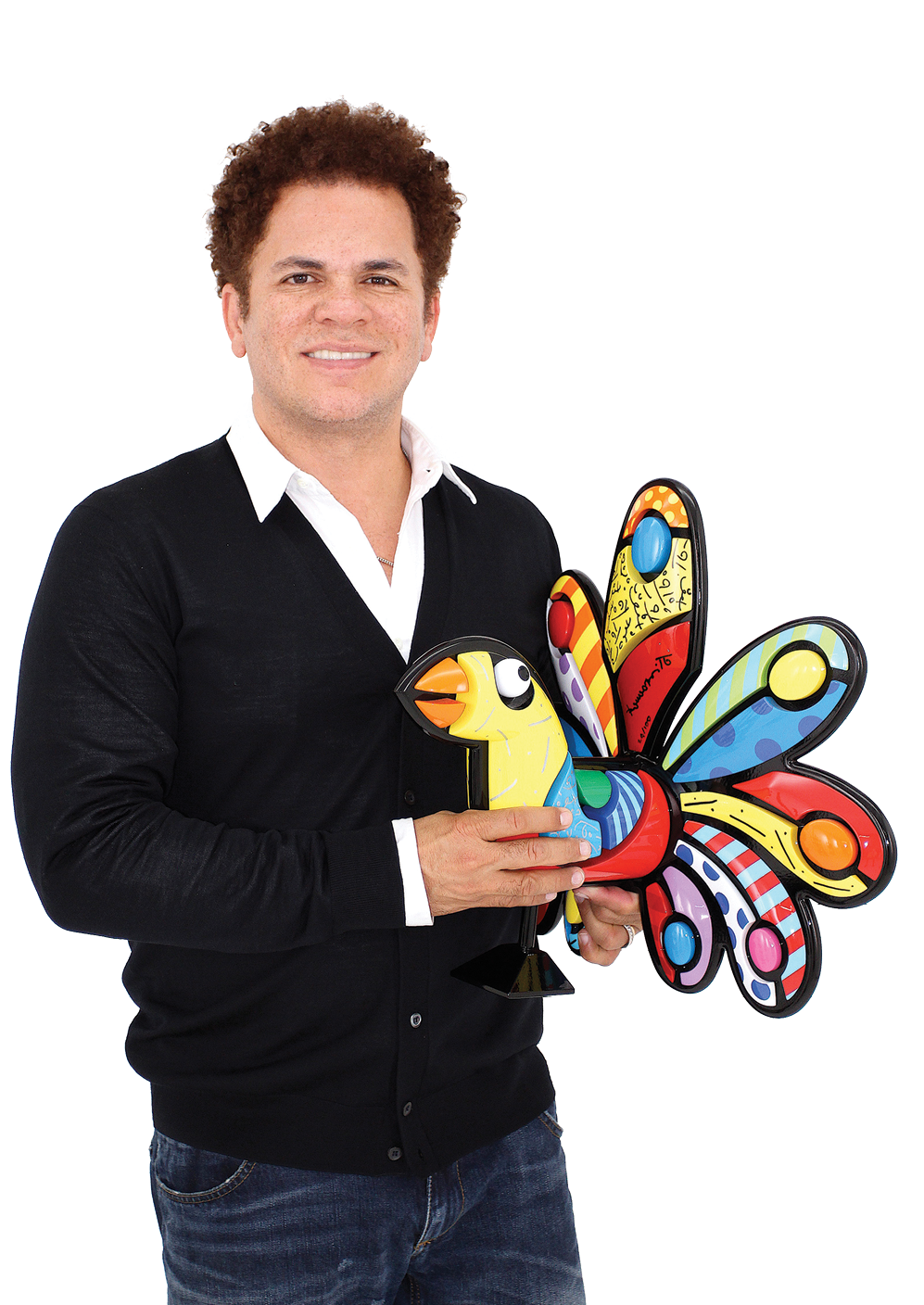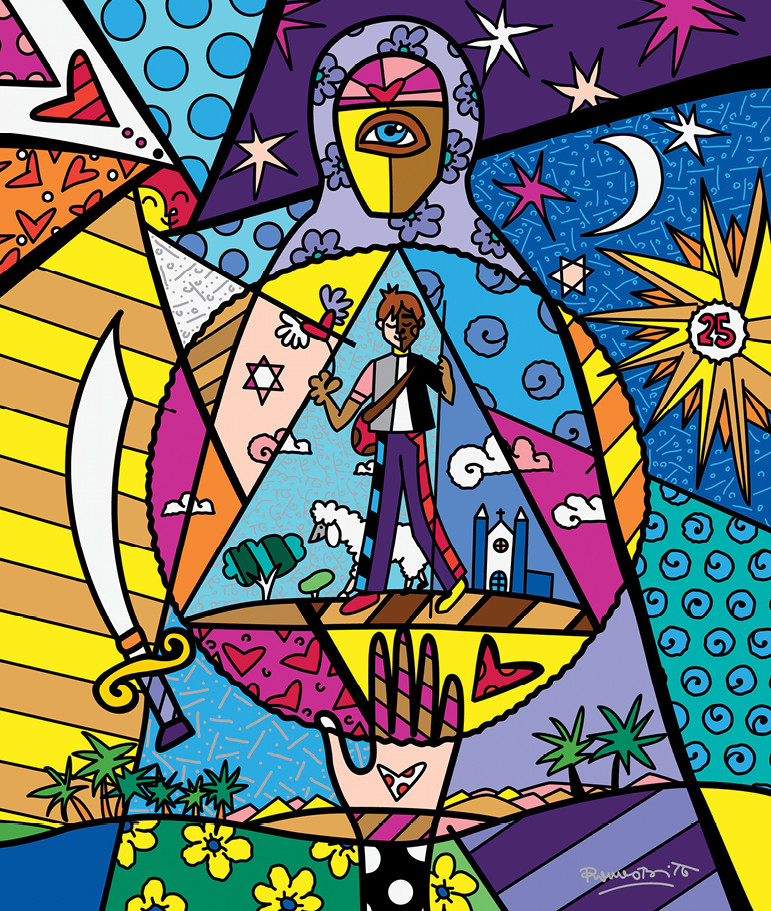


![]()
ONLINE


Romero Britto with Peacock
Creating Hope
Editors’ Note
Romero Britto (britto.com) has created a completely new expression that reflects his optimistic faith in the world around him. Alluding to influences of early and modern masters, Britto’s pulsating colors, pop themes, and commanding compositions have led to his becoming the premier contemporary artist of his generation. Britto lived an extremely modest lifestyle while growing up among eight brothers and sisters in Recife, Brazil. However, his innate creativity allowed him to fill his life with vibrant color and images of a beautiful world. He traveled to Europe in 1983 to examine firsthand the art of the masters. After exhibiting in a few galleries and private shows, Britto was encouraged to travel to the U.S., where pop art was flourishing. He moved to Miami and set up a studio open to the public. Britto spent the next few years exhibiting and attracting the attention of many. In 1988, he was selected alongside Andy Warhol and Keith Haring for Absolut Vodka’s “Absolut Art” campaign. Romero Britto has since been exhibited in galleries and museums in over 100 countries, including the Salon de la Société Nationale des Beaux Arts exhibition at the Carrousel du Louvre in 2008 and 2010. In December 2013, Maria Elena and Carlos Slim Domit invited Britto to be the first living artist to exhibit at Museo Soumaya. He has created public art installations for the 02 Dome (Berlin), John F. Kennedy Airport (New York), Cirque Du Soleil at Super Bowl XLI, and has been credited with the largest monumental sculpture in Hyde Park (London) history. He served as an official artist for the 2010 World Cup and was recently appointed Ambassador to the 2014 FIFA World Cup Brazil. Britto’s pop sensibility has since leant itself to many collaborations with such brands as Audi, Bentley, Coca-Cola, Disney, Evian, Hublot, Mattel, and Technomarine, to name a few. Romero Britto is an artistic activist for charitable organizations worldwide and most of all an artist who believes “art is too important not to share.” He serves as a benefactor, donating time, art, and resources to over 250 charitable organizations and sits on several boards, such as Best Buddies International and St. Jude’s Children’s Research Hospital. Britto was named an inaugural founding benefactor of the Harvard International Negotiation Program by Daniel Shapiro, a program that seeks peaceful resolution to modern conflict. Britto has been selected several times to be a speaker for the arts at the World Economic Forum in Davos, Switzerland. A firm believer in the role of an artist as an agent of positive change, Romero Britto is committed to developing and supporting the powerful role art plays in world issues.
How do you define “pop art” and how has it evolved?
In the past, pop art was about artists utilizing elements in their work that were meaningful to the masses.
It started with the Industrial Revolution when Americans were striving for success; artists were inspired by everything that was mass-produced, and they started creating art about it.
There was a group of pop artists in the U.S. and one in Great Britain. The American artists were embracing everything that was valuable for everyone, and artists in Great Britain were criticizing mass-produced things.
Today, we live in a world where everything is made on a grand scale; now we are in the middle of the digital revolution.
If Andy Warhol was alive today, he would be an equally amazing artist, sharing his work with billions of people. So it’s a huge opportunity for artists like myself who want to share their work with the world.
We definitely have evolved the pop art movement because we live it – we do it every day.
Does technology change the way art is done?
I still do paintings on canvas using brushes and paint, but there is another element in that I’m multiplying what I do with digital prints. I also work with the Internet in all sorts of ways.
It’s a huge boost to my business, so I embrace the new way of communicating with people.
Do you work on multiple pieces at one time? What is your process?
I start many paintings at once. I finish some almost at the same time. If I can work in various mediums and put all of my ideas out there at once, why not?
No matter what medium you’re working in, are there certain common traits so that a work is distinctly yours?
The message in my art is a very positive one. My wish is to create hope, positive and happy energies – everything must be hopeful.

Romero Britto's The Alchemist
Do you accomplish this primarily through the use of color?
I do utilize color and various subject matters.
Have you been surprised by how broad the interest is for your work?
It’s a huge honor to have a dialogue with so many different types and groups of people with varied interests, from the super-rich and highly sophisticated to the less wealthy and those not as knowledgeable about the art world.
The common ground among the groups is that we all have an appreciation for a positive message – happiness and doing good.
How broad is the opportunity for you to expand into areas that you haven’t touched upon yet?
There is so much out there. I’m interested in continuing to explore the opportunities online and elsewhere. I haven’t done nearly as much as I want to do.
I don’t want to just do art for the wall or for the pedestal. Artists like DaVinci did paintings, sculptures, and drawings – he went beyond painting and sculpting. He designed buildings and monuments. I also want to leave my mind open to other creative possibilities.
Do you sell product through your website or is buying art more of a tactile experience?
When you’re talking about a big move, like buying a painting or commissioning a portrait, people really want to meet the artist. There are so many things that people can acquire today that offer a piece of the artist but are not necessarily major acquisitions.
In some weeks, more than two million people come to view my site, Britto.com, which has an e-commerce component. I also have about 170,000 followers on my Facebook fan page, which is pretty unusual for a visual artist.
I think it’s all beneficial, keeping me going and keeping people supporting my work. It’s a win-win for everyone.
You’ve done pieces for some great and historic brands. How special has that experience been for you?
My first collaboration was with Absolut Vodka many years ago. It was a really huge moment because at that time, Absolut Vodka was the first company to ask artists like Andy Warhol to create paintings for use in ad campaigns.
When they asked me to do that, few knew about my work. After Absolut Vodka, I did work for Swatch, Grand Marnier, and Coca-Cola, as well as for the Grammys and the Super Bowl, and I did the largest public art installation ever in the history of Hyde Park.
The idea is to explore and be creative on canvas and through sculpture, as well as in different arenas that are available for myself and for other artists.
How tough is it to find the balance between running the business and being an artist, and making sure the time required for the business doesn’t inhibit your creativity?
My business supports my art. One feeds on the other.
How has your upbringing in Brazil impacted you?
Growing up in Brazil was very challenging but, as a result, I learned to appreciate good times, to identify opportunities, and not to limit myself. It was such a blessing to me to be born in a country with so much possibility and opportunity while there are also everyday struggles to contend with.
If you have nothing, it’s hard to grasp opportunity; but if you have everything, it’s also hard to appreciate and identify opportunities.
Was the desire to give back instilled in you early on?
Since I was a kid, I liked to share things with others.
I moved to America and I learned on a much bigger scale how much is done for the communities. People leave a legacy in things they do for others.
You don’t see this everywhere. My hope is that my work is going out there and inspiring people to overcome unhappiness. However, I find that in America, people don’t always want to get rid of bad things – many want to keep things the way they are. They don’t want to change the system. It’s not just about the government, but the people themselves.
One area you have supported for a long time is the fight against HIV/AIDS. What led to your interest in this cause?
AIDS is such a devastating disease. It’s about awareness and also acceptance. It should be about supporting efforts for finding the cure.
With the creation of your foundation, you’re also supporting young artists and art education. How important is it to provide an early introduction and awareness to art education?
Art can really inspire people. It can open a child’s mind, and the earlier you expose the child, the better, because kids can dream and create something unique. If you can get a young person to think that way, they will always think they can evolve from where they are. It’s a powerful state of mind.
Do you ever take time away from your work?
I’m always connected to what I do. I’m blessed to have this creative appetite that is constantly evolving. I enjoy what I do so it’s not work for me.•